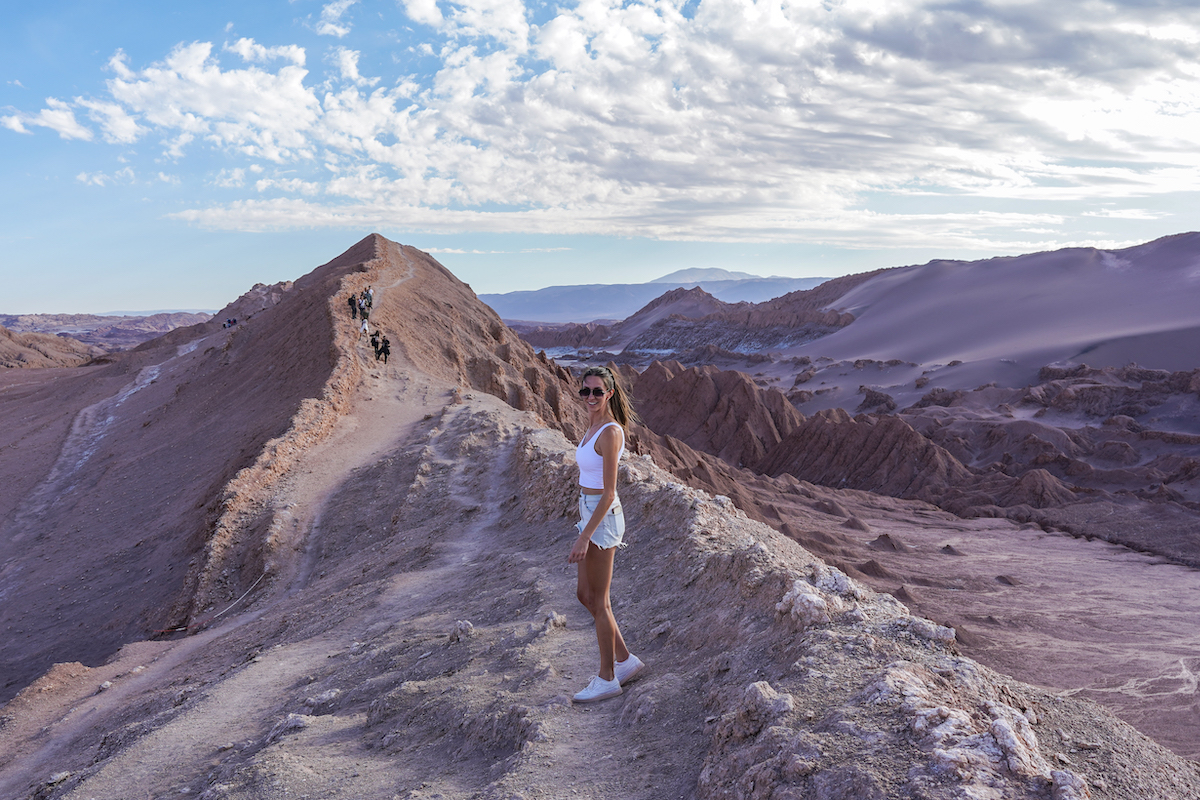
San Pedro de Atacama Chile is one of the top places to go in Chile due to its beautiful and unique landscape consisting of salt flats, sand dunes, lagoons and geysers. There are a lot of things to do in the Atacama Desert and if you have the time, it’s worth exploring for a few days.
The Atacama Desert covers an area of about 41,000 sq. miles. It’s located in the northern part of Chile between the Andes mountains and the Chilean mountain range or Cordillera de la Costa.
It’s the driest non-polar desert in the world and is surrounded by mountains and volcanoes. In fact, some of the places you visit will give you a 360º mountain/volcano view. Chile has around 2,000 volcanoes within the country and many of them are in the San Pedro area.
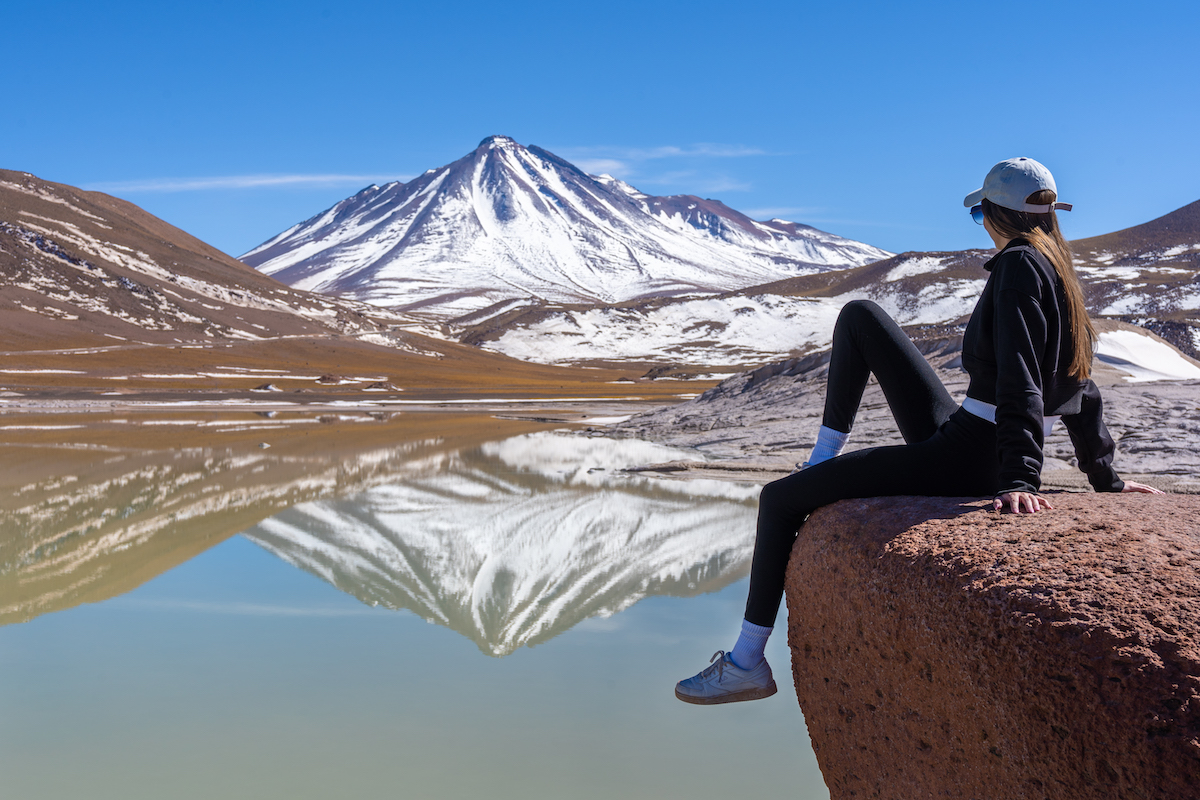
How to Get to San Pedro de Atacama
If you want to explore the Atacama Desert, you’ll want to make your way to San Pedro in the north of Chile. This is the central town in which you can stay and the starting point of all the tours. The easiest way to get to San Pedro is by first flying into Calama and then transferring to San Pedro from there.

The flight from Santiago to Calama is about 2 hours. Then you’ll need to either drive or transfer from Calama to San Pedro which is about an hour and a half.
By Bus
I planned on taking the bus to San Pedro initially as it seemed pretty straightforward from Calama to San Pedro and only cost $5 for a one-way ticket. However, I opted out once I looked into it further and found out the buses don’t leave from the airport. They leave from different places in the city center (depending on the company you choose) and you’d then have to pay to get to the city center.
Since I was traveling solo, I wanted to minimize the amount of logistics I’d have to figure out (and minimize the risk of getting lost), so I opted for a private transfer.
By Private Transfer
There are several companies that offer a private van transfer straight from the airport in Calama to your accommodation in San Pedro. This is the most convenient way to go and wasn’t terribly expensive. I paid $29 for a roundtrip transfer.
They wait at the airport with your name on a sign, guide you to a comfortable van and drop you right off at the front door of your lodging in San Pedro. Then they pick you up and take you back when you need to be at the airport.
By Car
If you plan on exploring the Atacama Desert on your own, then it’s best to rent a car from Calama and drive to San Pedro. The drive is very straight forward with empty roads and desert views. It’s paved most of the way but when you get into San Pedro, you’ll encounter lots of rocky/dirt roads.
Many of the attractions also have rocky dirt roads so just something to be aware of. Do you need a 4×4? Debatable. Some of the locations are more remote and having a 4×4 would be a smart idea but not necessarily required.
Things to Do in the Atacama Desert
San Pedro is an interesting town. It’s in the middle of the desert and is pretty much all adobe buildings and dirt roads. The main road, Caracoles (seen below), is a dirt road lined with travel agencies and restaurants. There’s not a whole lot to do here but it’ll be your home base while you go see the attractions in the area.
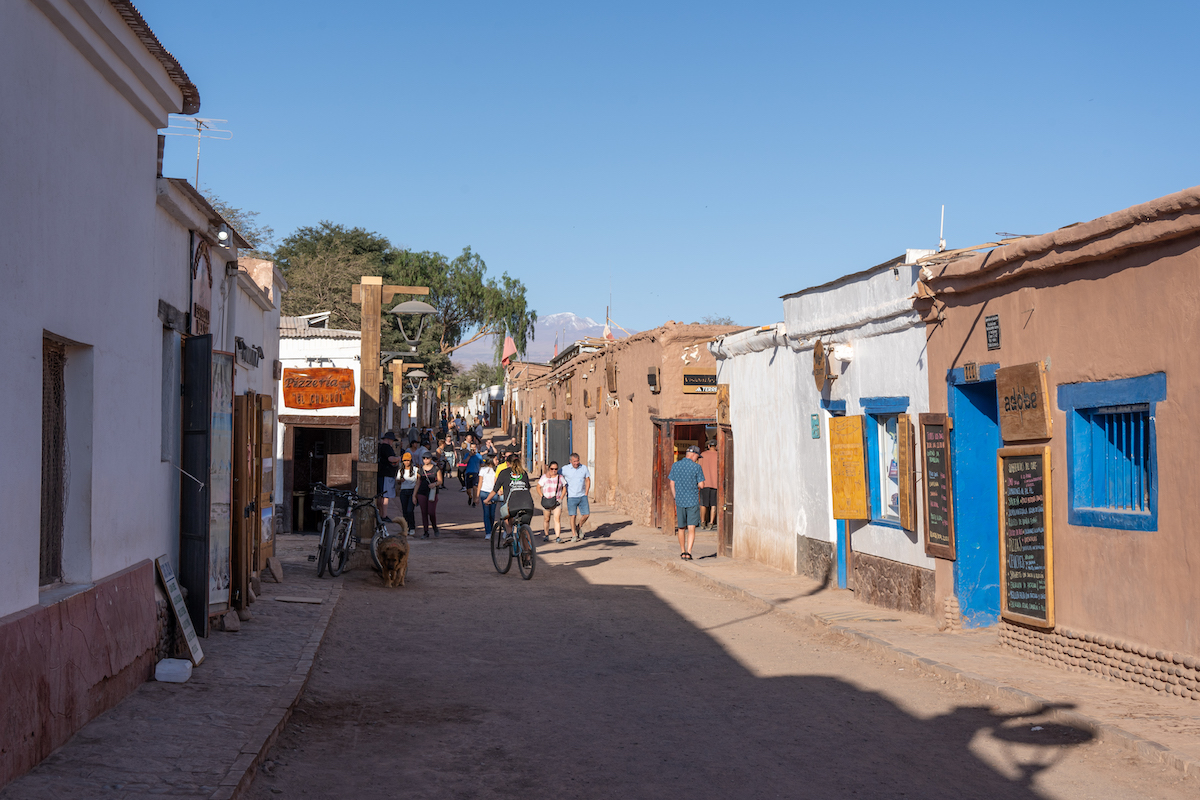
Unless you’ve rented a car, you’ll be booking tours to the main attractions which can be within 30 minutes of San Pedro or around an hour and a half. There are some great things to see whether you’re spending a day or several days in the Atacama Desert. Either way, here’s a rundown of some of the best things to do in the Atacama Desert.
Piedras Rojas (Red Stones) and Salar de Talar
The Red Stones or Piedras Rojas is one of the most popular things to do in the Atacama Desert. And don’t let the names confuse you (they confused me)–Peidras Rojas and Salar de Talar are the same place.

The red stones are situated right next to a lagoon that’s lined with mountains. It’s an incredibly scenic place and a great spot for reflection photography too if it’s not windy. You can walk right up to the edge and wander around the red rocks.
Laguna Chaxa
Flamingos in Chile? Yep! And you can see them at the Chaxa Lagoon. There’s actually three different kinds of flamingos that can be found in Chile: Chilean flamingo, Andean flamingo and the James flamingo.
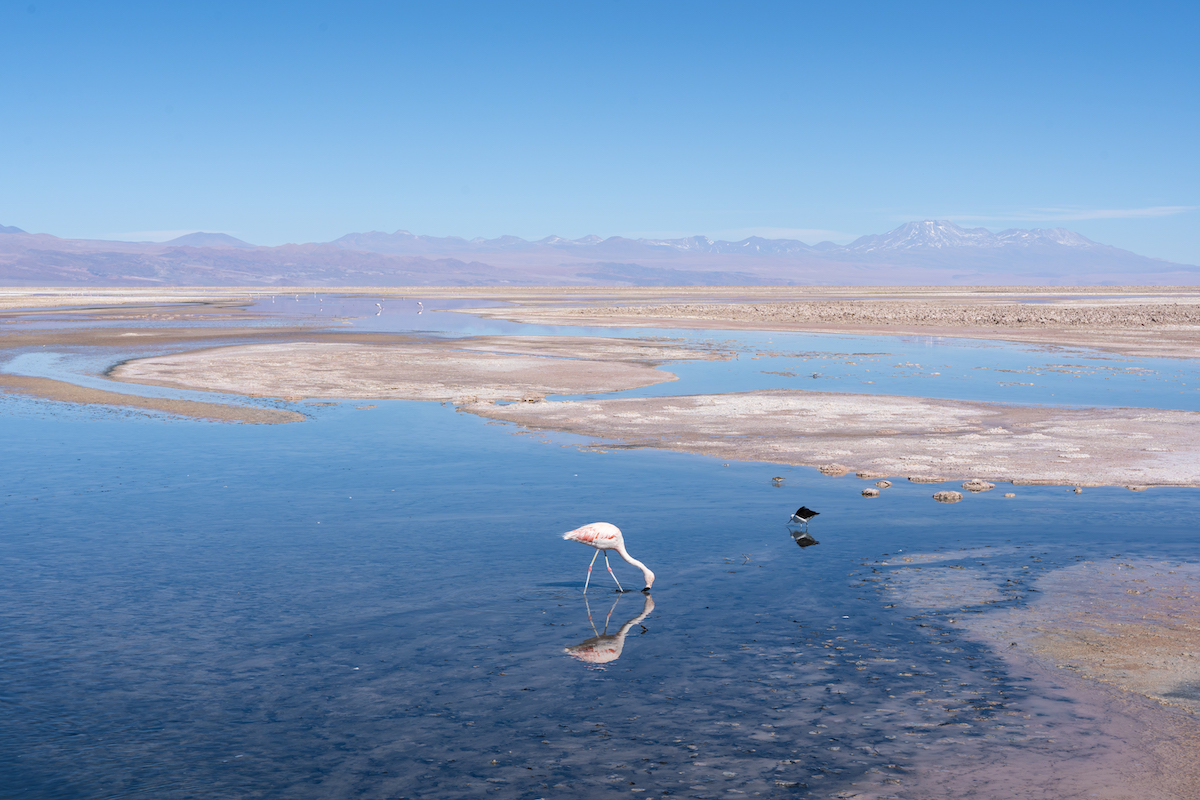
The Chaxa Lagoon is a huge salt flat in a valley that is surrounded by mountains and volcanoes any which way you look. There’s a path through the salt flats that you can walk down and view the flamingos that are next to it. You also might want to have binoculars for any wildlife that might be further away.
Stargazing in the Desert
The Atacama Desert is known for being one of the best places to go stargazing due to several factors. Its lack of light pollution is a main cause but it’s also due to the high altitude and the fact that it’s one of the driest places on earth. You’re likely to have a clear night sky for astrology observation and tours will have all sorts of telescopes and photo ops for you.
HOWEVER–this is very important–you’ll want to keep an eye on the dates that you visit. I conveniently booked my trip right in the middle of a full moon cycle and most of the tours shut down during the days before and after a full moon as the stargazing won’t be as good. So no, I did not get to go stargazing, ugh.
Salar de Aguas Calientes
There are quite a lot of salt flats and lagoons to see in the Atacama Desert. Salar de Aguas Calientes is another one that you might stop at on a tour or one you can drive to on your own. We didn’t drive down to the edge but rather stopped at the viewpoint.

Salar de Aguas Calientes has some really neat patterns and colors seen from above. It’s also a place to spot wildlife but you’ll need binoculars from the viewpoint. When we visited, it was also incredibly cold and windy at the top that I could hardly stay close to the edge. Something to keep in mind when you visit!
Laguna Cejar
One of the most popular lagoons to visit in the Atacama Desert is Laguna Cejar and that’s because you can swim/float in it! The salt concentration is so high here that you can casually float and get those floating pictures. It also has a great view of the mountains/volcanoes nearby.
I actually had this on my itinerary and ended up cancelling it so I could go sandboarding instead. Sandboarding was on my bucket list and I didn’t know when else I would fit it in and I already had several lagoons I would be seeing. Laguna Cejar is also not the only lagoon you can float in!
Valle de la Luna (Valley of the Moon)
One of the most otherworldly looking places in the Atacama Desert is Valle de la Luna or Valley of the Moon. This desert area has sand dunes and rock formations but can also have a white salt dusting on top of the sand.
My guide told me it’s due to weather conditions and isn’t always present, but when it is, it can stick around for several days. It’s quite an interesting phenomenon as some of the places look like they’re covered in snow.
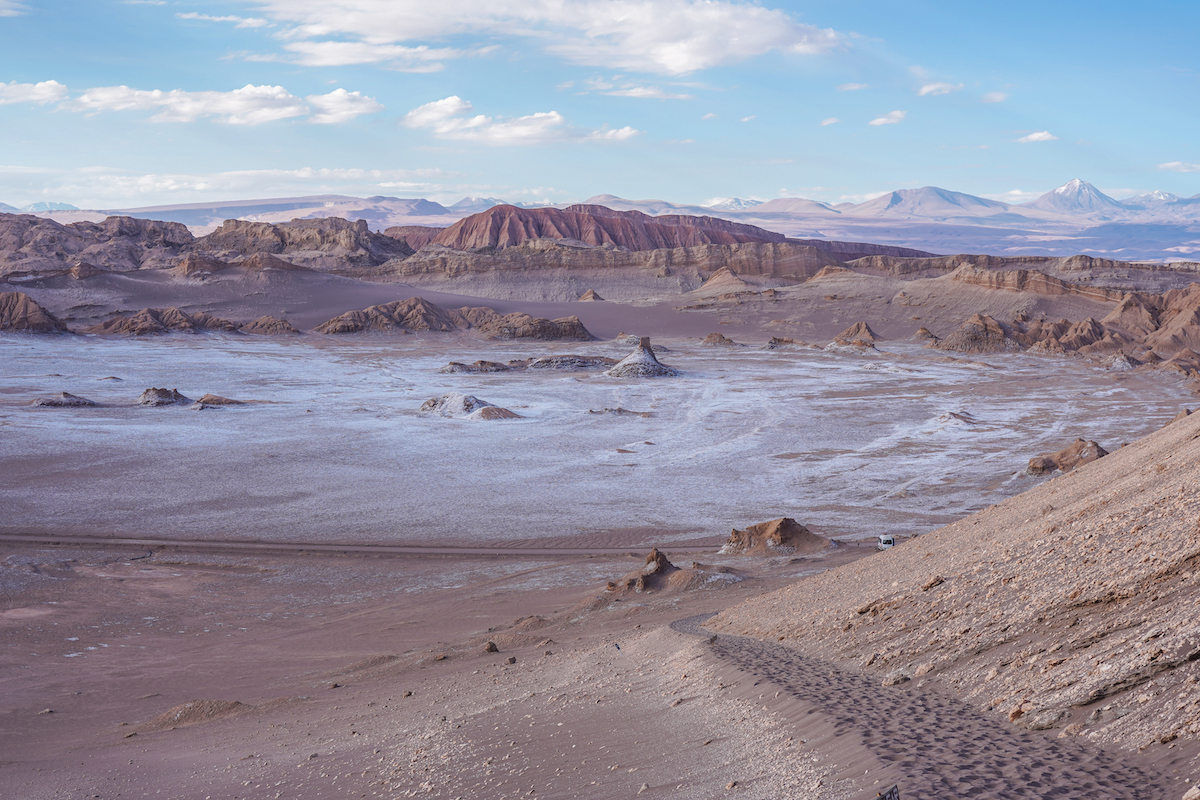
Moon Valley is also quite large and there are many places you can visit within the park. I definitely could have stayed and explored more here. There’s also a popular viewpoint called Mirador de Kari just outside the park that everyone goes to for a sunset view over the valley.
Lagunas Altiplánicas (Miscanti and Miñiques Lagoons)
Two other popular lagoons are the Miscanti and Miñiques Lagoons which are high altitude lagoons. Both are supposed to be very scenic. These were included on one of my tours but because of the weather, they were closed. Evidently they were both covered in snow (I visited in April, which is Fall for Chile).
El Tatio Geysers
The tour to the Tatio geysers is a bit of a commitment as most of the tours have a pickup time around 4:30am. It’s a rough morning but totally worth it. It takes about an hour and a half to drive up to the geysers, which are at a pretty high altitude: 14,173 feet (4,320 m). It’s a neat place to visit as you can walk right up to and around all the geysers.
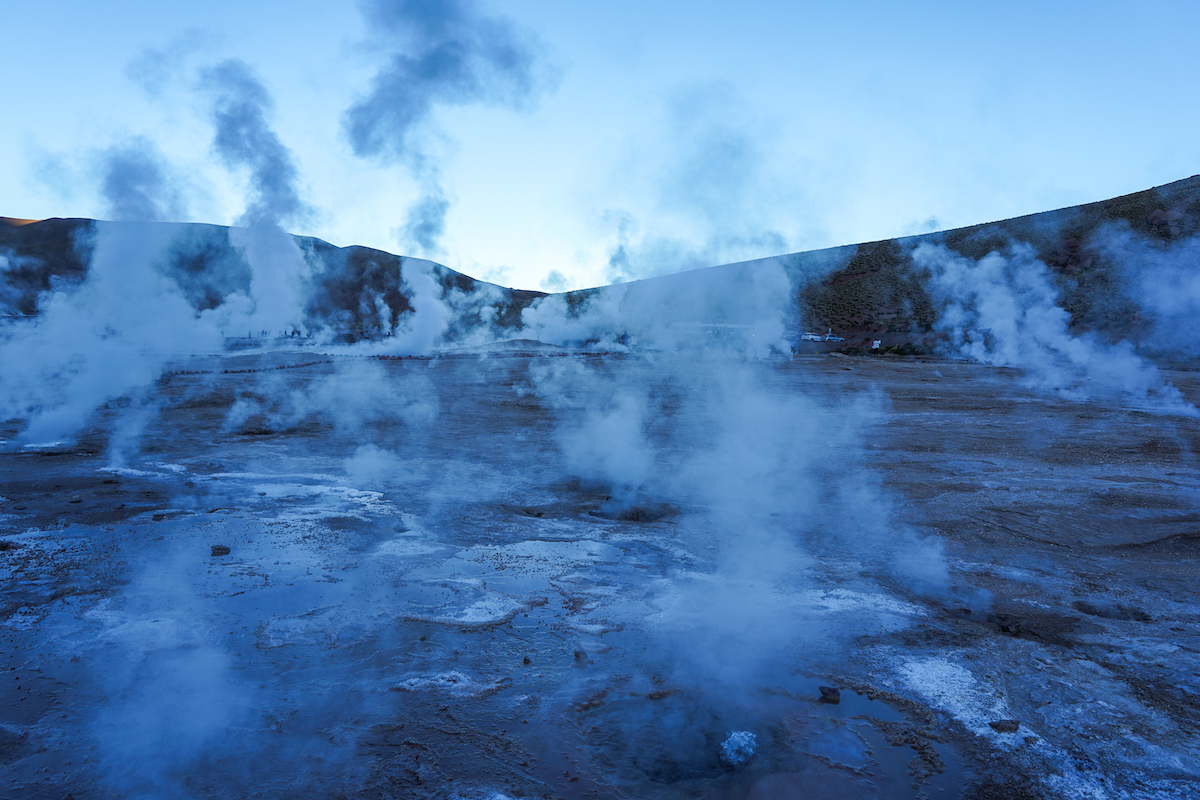
The reason the tours leave so early is because of the steam from the geysers. These geysers don’t have a high water spout but they do create billowing pillars of steam, which are best seen right before the sun comes up. Once the sun is fully up, it’s hard to see the steam as the contrast isn’t as strong.
Valle del Arcoiris (Rainbow Valley) + Petroglyphs
Rainbow Valley or Valle del Arcoiris is a short hike through colorful rock formations. While there were definitely some different rock colors, it wasn’t as much of a contrast as I expected. I think part of that reason too was due to going on this tour in the morning. I think the colors would have popped more in the afternoon sun as they were a bit washed out in the morning.
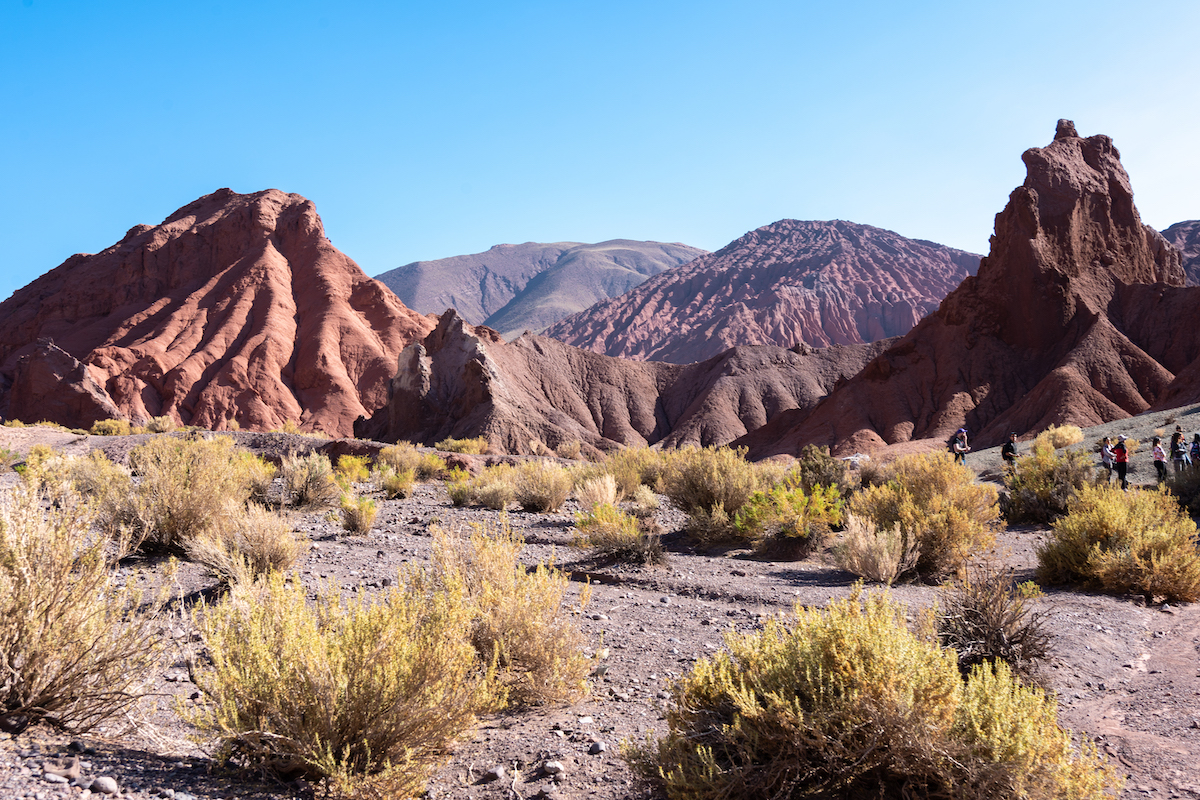
I asked several guides what their favorite place to visit was and several of them said Rainbow Valley. It was nice to walk around, but I think I had too high of expectations from having explored Utah quite a bit. I was expecting something a bit more awe-inspiring like you’d see in Utah and I didn’t quite get that here.
The other half of the tour is seeing the petroglyphs. There’s a large rock area and many petroglyphs to see along the trail.
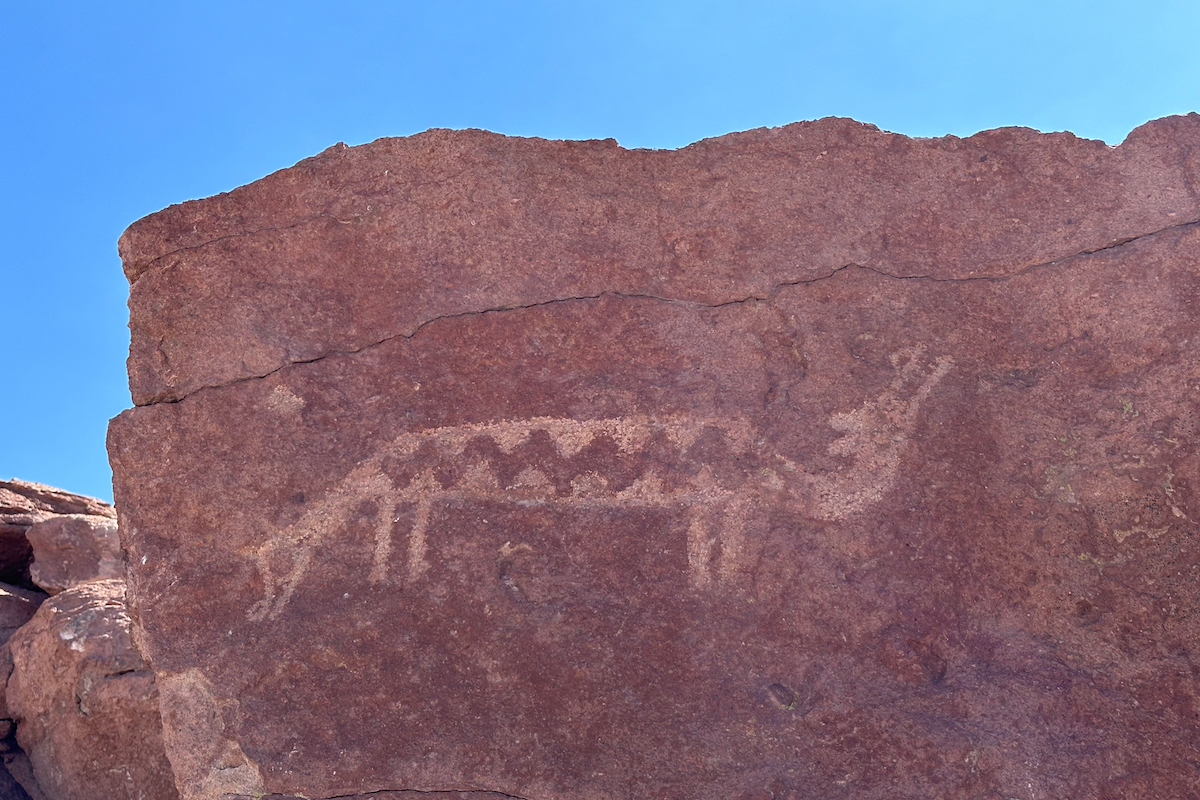
Lagunas Tebenquiche
Another lagoon with a high salt concentration is Lagunas Tebenquiche. This will be another likely stop when visiting the Laguna Cejar. While you can’t swim in this one, this lagoon is a great reflection spot with the mountains next to the water.
Sandboarding in Death Valley
Not far out of San Pedro is where you’ll find Valle de la Muerte (Death Valley aka Mars Valley). This is a popular spot to go sandboarding in Chile and the drive back into this area is pretty neat also as the road takes you right up next to rock formations. You’ll eventually come across a large sand dune where there’s benches at the bottom and sandboarders.

A sandboarding tour will include all the gear such as your board, boots and helmet. When I went, there were only two other people in my group plus my guide. It was a fun evening, but I will say sandboarding is definitely a bit harder than snowboarding.
People were eating sand right and left, but we had a lot of fun. And the downfall of course is having to walk up a big sand dune every time you want to go down again. But it did have a great sunset view from the top!
Baltinache Lagoons
These are often referred to as the Hidden Lagoons of Baltinache. The turnoff for this attraction isn’t too far from San Pedro, however, the journey is in the long dirt road that drives straight into the desert. It’s a long, bumpy ride for about 30 minutes.
The area has a lot of unique salt formations and if you’ve ever been to Death Valley in California, this reminded me of the Devil’s Golf Course. There’s prickly looking formations for as far as you can see and even some of the salt crystal shapes that you’d see at Badwater Basin in Death Valley, CA.
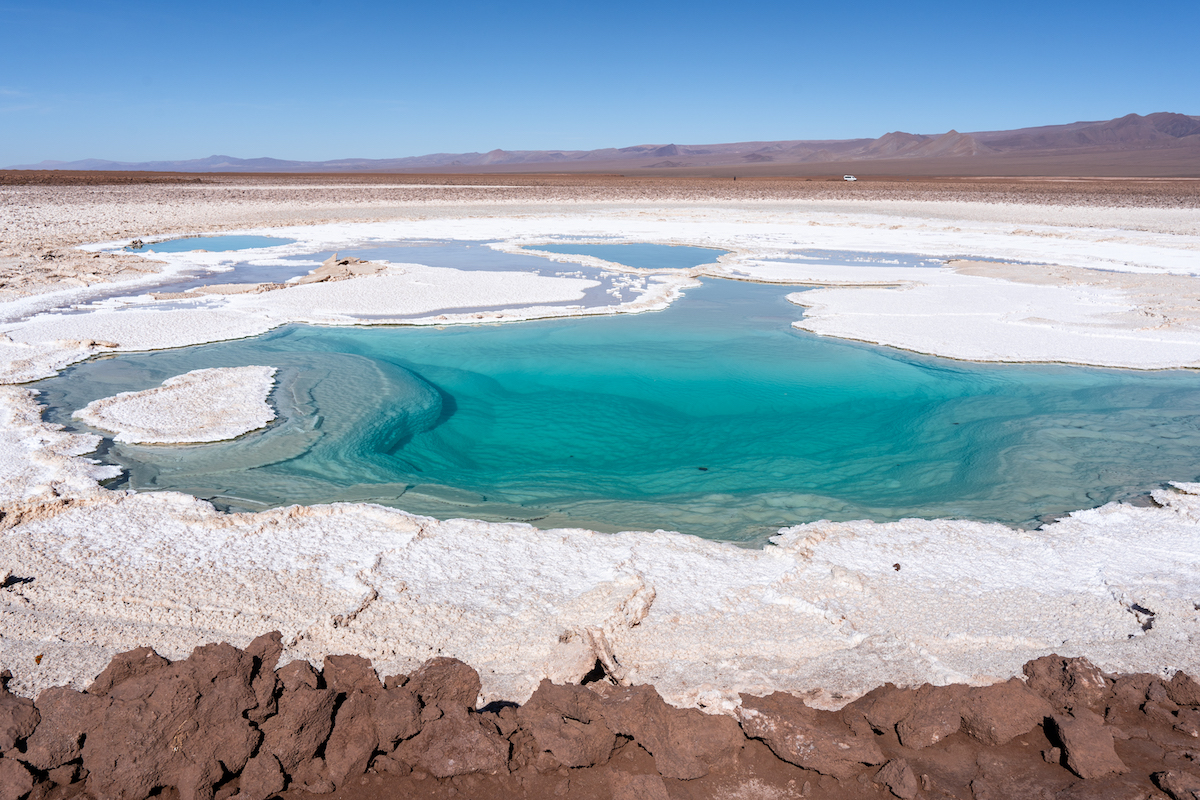
But in the middle of the salt formations are seven turquoise lagoons. Some are darker in color due to the sediment but others are bright turquoise. The last lagoon is one you can swim in and because of the high salt content–float in! I have to say, the water was extremely cold which was a weird contrast to how hot it was outside.
Where to Stay
The main road in San Pedro is called Caracoles and that’s where you can find all the tour agencies and restaurants. I’d recommend staying within walking distance of the main road so you can walk to restaurants after your tours. Even if you have a rental car, the roads nearby are pretty narrow and Caracoles is a walking street.
Accommodations will be pretty basic unless you of course are willing to pay more. I stayed at KM Zero and it was a 2 minute walk from the main road and a basic room. The owners didn’t speak English but I got by with Google translate ha. Otherwise, there are plenty of hostels, mid-range places and several higher end places also.
What to Bring to the Atacama Desert
My entire 10 days in Chile can be summed up in one word: unprepared. I visited in the Fall, looked up the weather beforehand and was the most underdressed person on every tour I went on. And that’s because San Pedro sits at an altitude of about 8,000 ft and many of the attractions are at an even higher altitude.
I missed this very important fact when doing my research.
And even if you are visiting in the summer, you’ll still be at a high altitude and temperatures in the desert always drop at night, so you’ll want to be prepared. People on my tour showed up looking like they were hiking Patagonia and I showed up looking like I was going to the gym. Was I cold? YES. But I survived.
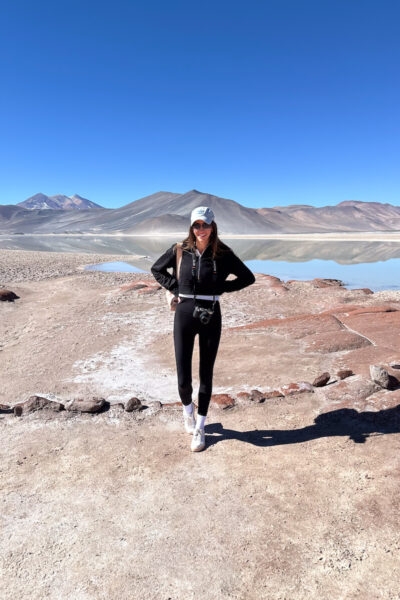
- Good tennis shoes–I didn’t hike too much, but you’ll be doing some hiking at the very least so you’ll want comfortable shoes.
- Long socks–if you plan on going sandboarding
- Layers–The temperatures in the Fall can get HOT from about 1-5pm but COLD any other time, so make sure you have everything from tank tops and shorts to jackets/coats and pants.
- Gloves/hat–Especially when visiting the Tatio Geysers at the crack of dawn
- Backpack–To hold all your layers ha
- Windbreaker–the wind can get very strong at some of the viewpoints and very cold!
- Sunscreen–Even if it’s cold, you’ll be at a high altitude with strong sun rays
- Water bottle–Make sure you have plenty of water because of the altitude! You can buy a large water bottle at the market too to have on the bus.
- Advil/Altitude meds–If you get altitude sickness easily, you might bring something with you. I had a headache about half the time I was there.
Best time to visit the Atacama Desert
Despite being drastically unprepared for the Fall weather, it wasn’t a bad time to visit. Had I have done a bit more research on the altitude, I would have packed a bit better.
The weather warmed up during the day and was nice and pleasant. The mornings were especially cold up until about noon and the wind did make it even colder at times. But if you’re better prepared than I was, you should be fine.
The Atacama Desert doesn’t really have a bad time to visit. Though based off my visit, the winter season (June-September) would be pretty cold and the Lagunas Altiplánicas were closed due to snow. Something to keep in mind.
And if you’re set on stargazing, then you’ll definitely want to plan your visit to the desert when there is not a full moon! Otherwise, it’s a great place to spend a few days as there are a lot of things to do in the Atacama Desert. Check out my Atacama Desert itinerary for how I spent my trip!
PIN IT FOR LATER
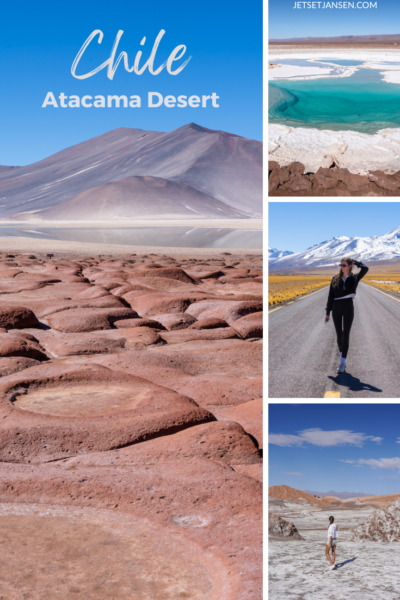

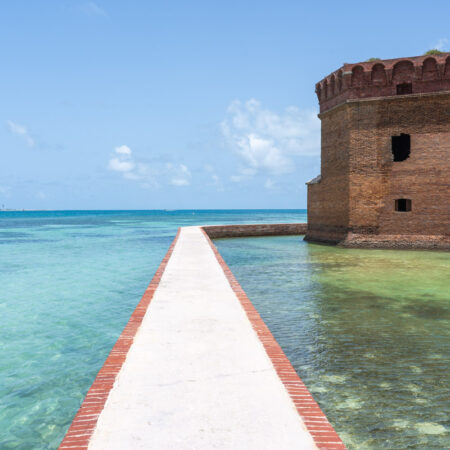
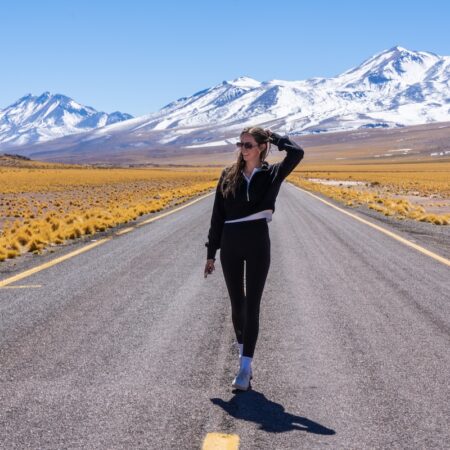
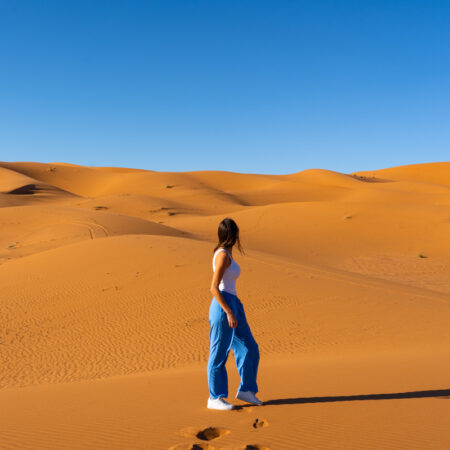
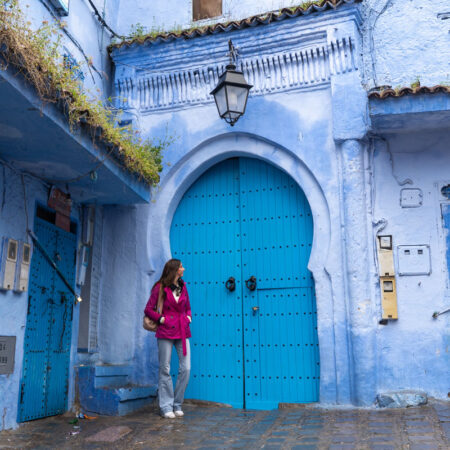

We have done a fair amount of travel in Chile but sadly have not yet made it to the Atacama Desert. Good to learn more about how to get there. And what to do when you visit. I expected sand and dunes but the Red Stones look very cool too! Good to know to plan your visit timing if you want to stay for stargazing! Definitely still high on my list when we do return to Chile.
The country is so long I feel like there are so many places to visit. I’d like to return at some point as well!